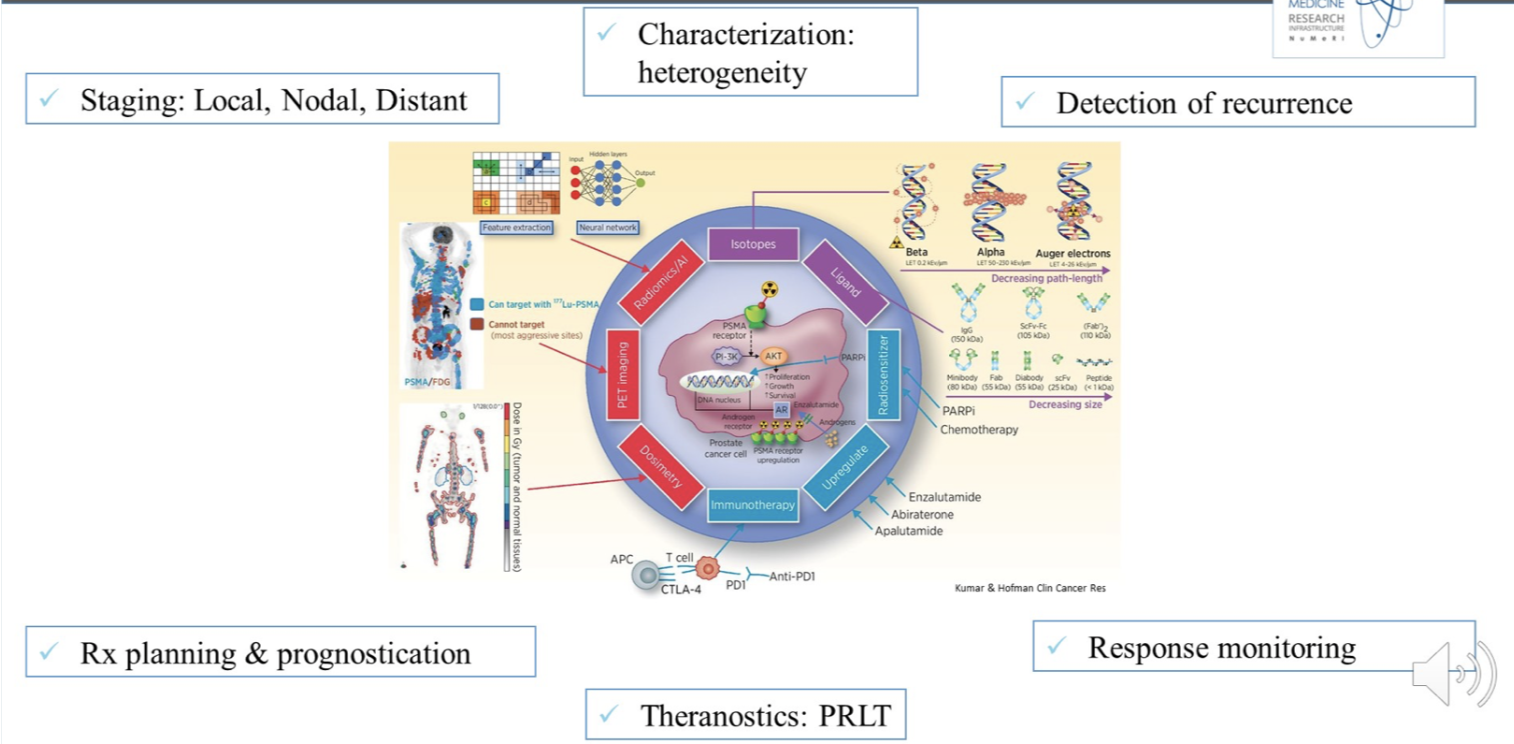(UroToday.com) In a plenary presentation in the Progress and Promise in Treatment Personalization for Advanced Prostate Cancer session at the 2021 American Society of Clinical Oncology Genitourinary Cancers Symposium (ASCO GU), Dr. Sathekge provided a talk examining the role of Lutetium in prostate cancer.
Across the spectrum of prostate cancer, Dr. Sathekge highlighted that there are important roles for PSMA based approaches for initial staging of local, nodal and distant disease; in characterizing disease heterogeneity; in the detection of recurrence; in treatment planning and prognostication; in response monitoring; and in theranostics with molecularly targeted treatments.

Dr. Sathekge highlighted the molecular structure of the PSMA transmembrane glycoprotein. While this protein is expressed at basal levels, expression is elevated in cancer, leading to its utility for all of the indications described above.

In the staging context, he provided data demonstrating the utility of PSMA-PET/CT for primary tumor, nodal, and distant metastatic staging for patients with high-risk disease. He highlighted data from the proPSMA trial to this end. Further, detection of recurrent disease is feasible at much lower PSA levels, as compared with conventional imaging.
Dr. Sathekge then emphasized the importance of FDG imaging – where FDG and PSMA are co-expressed, theranostic treatment is unlikely to be successful. This, co-utilization of these modalities is necessary to allow for molecularly-targeted treatment.
In the context of theranostics, Dr. Sathekge highlighted the “simple” mode of action with targeted radiotherapy delivery. This localized radiotherapy dosage leads to DNA strand breaks leading to cell death.

As already alluded to, Dr. Sathekge emphasized the importance of multidisciplinary involvement in patient selection including appropriate imaging findings, tumor progression on active therapy, appropriate hematologic, renal, and hepatic function, and appropriate disease indication (mCRPC).
Use of 177-Lu-PSMA is feasible with reasonable disease control, reductions in PSA, and improvements in pain and quality of life. However, 30-35% of patients fail to respond. Importantly, he emphasized that PSMA expression is strongly positively correlated with the response to theranostic treatment.
In his context in Pretoria, they identify patients with advanced disease and aggressive tumor biology. Given this, and access to therapies, appropriate sequencing is undertaken in a multidisciplinary fashion. Utilizing data from the WARMTH study, he emphasised the importance of ECOG status, liver metastases, and bone metastases in terms of prognosis for patients receiving 177-Lu-PSMA.
He then mentioned data from the TheraP trial demonstrated better PSA responses and lower toxicity with the use of 177-Lu-PSMA as compared to cabazitaxel in men with docetaxel pre-treated mCRPC.
Moving forward, Dr. Sathekge discussed the question of treatment sequencing, highlighting data showing good responses to 225-Ac-PSMA in the chemo-naïve patient population. Further, he emphasized the potential for re-treatment with 17-Lu-PSMA, with rechallenge with this approach associated with better responses than many other systemic therapies.
In terms of toxicity, Dr. Sathekge emphasized the potential for xerostomia given the presence of PSMA in the salivary glands. Strategies to reduce toxicity include dose de-escalation, combination therapy, and new classes of albumin-bound PSMA radioligands.
Further, Dr. Sathekge emphasized the potential for combination therapy with theranostics and androgen-axis targeting agents. Additionally, advanced imaging approaches can be used to identify PARP expression to allow for targeted use of PARP inhibitors in patients most likely to benefit.
Dr. Sathekge closed by highlighting that Lutetium offers the potential for targeted treatment with improvements in survival outcomes and quality of life.
Presented by: Mike Machaba Sathekge, MD, Ph.D., is a Professor and Head of Nuclear Medicine department at University of Pretoria. He is Chairman of the Medical Research Council of South Africa.
Written by: Christopher J.D. Wallis, Urologic Oncology Fellow, Vanderbilt University Medical Center, @WallisCJD on Twitter during the 2021 American Society of Clinical Oncology Genitourinary Cancers Symposium (#GU21), February 11th-February 13th, 2021


